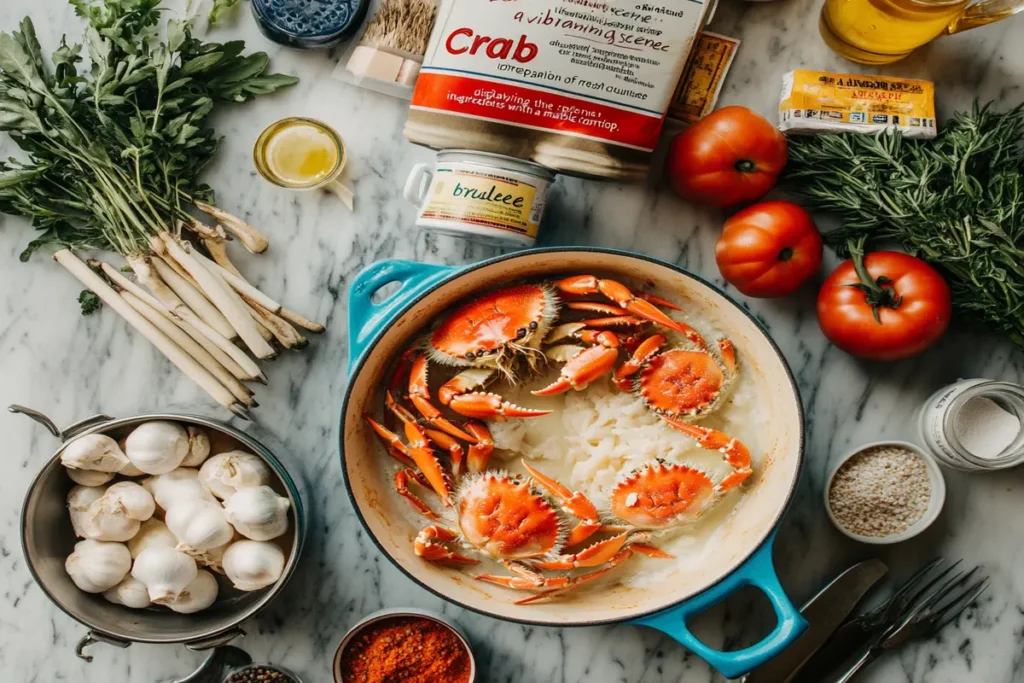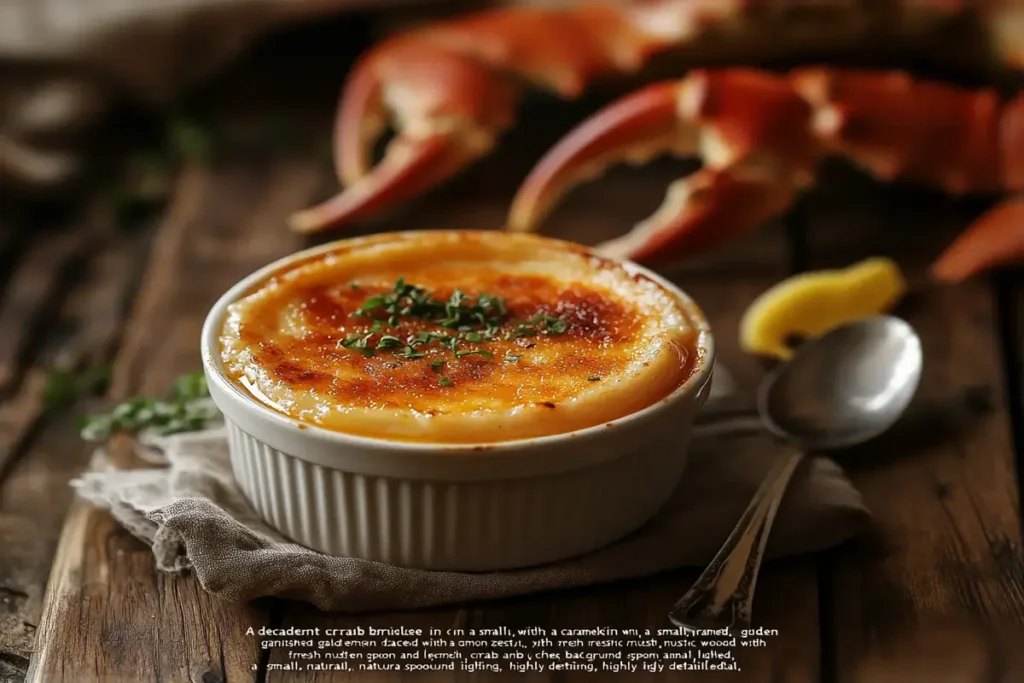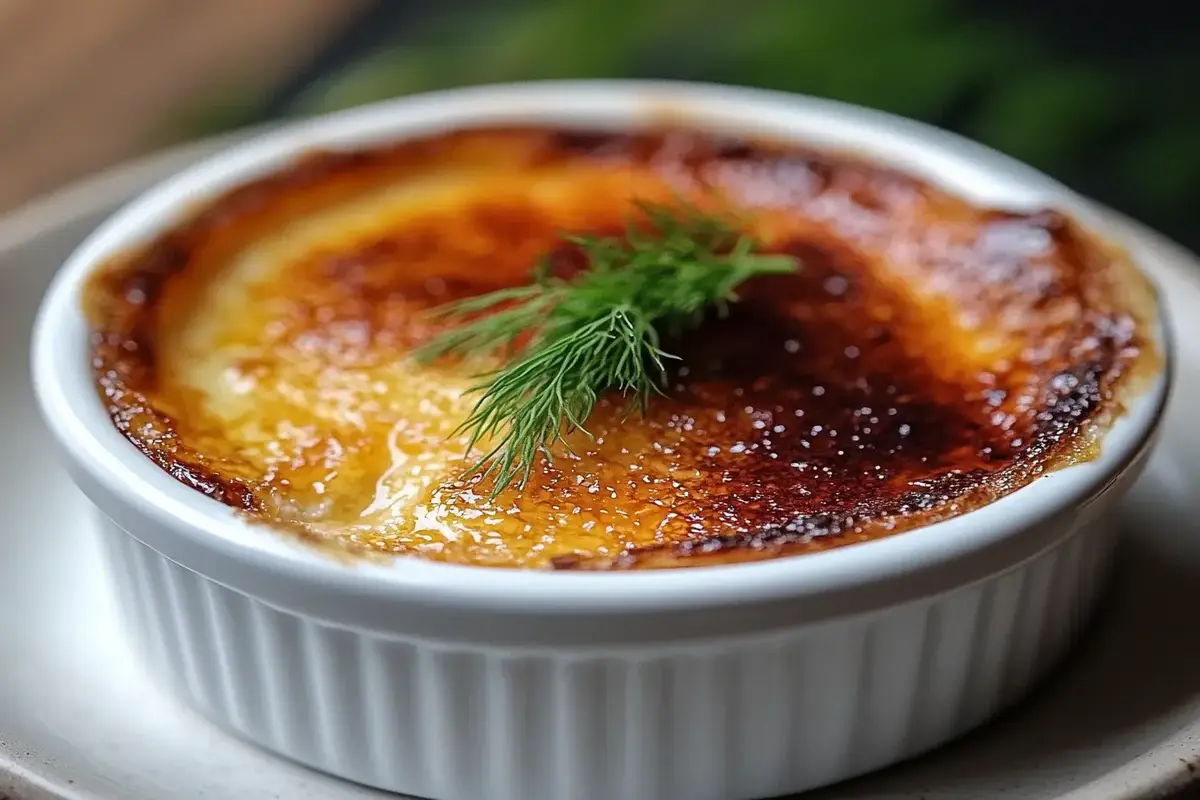Crab Brûlée is a luxurious twist on the classic crème brûlée, merging the savory sweetness of crab meat with the creamy custard texture we all love. This indulgent dish is perfect as an appetizer or a gourmet treat to impress your guests. In this guide, you’ll learn everything you need to know about preparing the perfect crab brûlée recipe. From essential ingredients to step-by-step instructions, and even troubleshooting tips, this article will leave you fully equipped to create a masterpiece in your kitchen.
Introduction to Crab Brûlée Recipe
What is Crab Brûlée?
Crab Brûlée is a savory interpretation of the classic French dessert crème brûlée. Instead of focusing on sugar and vanilla, this dish highlights the richness of crab meat paired with a creamy custard base. A thin, crispy caramelized layer on top adds a delightful crunch to balance the silky texture underneath. This savory brûlée is a true crowd-pleaser, combining the elegance of fine dining with the comforting familiarity of seafood.
The History and Origins of Crustacean-Inspired Brûlée
While crème brûlée traces its origins back to 17th-century France, its savory adaptations are a more modern culinary trend. Savory brûlées gained popularity as chefs experimented with reimagining traditional desserts into appetizers or main courses. The incorporation of crab meat reflects a growing appreciation for seafood in upscale cuisine, creating a blend of innovation and tradition.
Why This Recipe is Unique and Gourmet
The crab brûlée recipe stands out because of its luxurious ingredients and versatile nature. It can be served as an appetizer at a sophisticated dinner party or as a comforting yet refined family treat. The subtle sweetness of the crab meat complements the creamy custard, while the caramelized top layer adds a textural contrast that elevates the dish. This combination makes it an unforgettable experience for both seasoned foodies and casual diners.
Ingredients Needed for Crab Brûlée
Essential Ingredients for the Perfect Crab Brûlée
Creating a crab brûlée recipe requires a delicate balance of high-quality ingredients to ensure maximum flavor. Here’s what you’ll need:
- Fresh crab meat: Opt for lump or claw meat for the best texture and flavor. Fresh crab is ideal, but high-quality canned crab works as a substitute.
- Heavy cream: A rich and creamy base is essential for that luscious texture.
- Egg yolks: These are the backbone of your custard, providing thickness and a silky finish.
- Parmesan cheese: Adds a nutty depth to the flavor.
- Seasonings: Salt, white pepper, a pinch of paprika, and a dash of cayenne for a subtle kick.
- Sugar: For the caramelized topping, granulated sugar works perfectly.
Substitutes and Alternatives for a Personalized Twist
If you’re experimenting, you can substitute lobster or shrimp for crab to create exciting variations of this dish. For a dairy-free option, try using coconut cream instead of heavy cream. Want to enhance the flavor? Add a splash of sherry or a sprinkle of fresh herbs like dill or chives.
Choosing the Best Crab Meat: Fresh vs. Canned
Fresh crab meat is the gold standard for flavor and texture, but canned crab offers convenience without sacrificing too much quality. When buying canned, look for pasteurized options labeled “jumbo lump” or “special.” Avoid any with preservatives that might affect the taste.
Equipment and Tools for the Recipe
Kitchen Essentials for Crab Brûlée Preparation
To craft a perfect crab brûlée recipe, you’ll need some basic kitchen tools:
- Mixing bowls: For whisking and combining ingredients.
- Whisk: Ensures the custard is smooth and lump-free.
- Ramekins: Use small, oven-safe dishes to portion out the brûlée evenly.
- Baking dish: For the water bath, which ensures gentle cooking.
Special Tools for the Caramelized Topping
The crispy, caramelized top layer is the hallmark of any brûlée. Here’s what you’ll need:
- Kitchen torch: This handy tool provides precise control for achieving that perfect golden crust.
- Sifter or fine-mesh strainer: To evenly distribute sugar across the surface for caramelization.
Step-by-Step Instructions for Making Crab Brûlée
Preparing the Crab Filling: The Perfect Blend of Flavors
The foundation of a delicious crab brûlée recipe lies in its filling. Start by ensuring your crab meat is free of shell fragments and gently pat it dry to remove excess moisture. Combine the crab with Parmesan cheese, a dash of cayenne, and a pinch of salt for seasoning. These ingredients will enhance the natural sweetness of the crab while adding a hint of spice.
Making the Creamy Custard Base
The custard is what gives this dish its rich and luxurious texture. In a mixing bowl, whisk together egg yolks and heavy cream until smooth. Add a sprinkle of white pepper and a tiny pinch of paprika to the mixture. For an extra layer of flavor, a splash of sherry can be whisked in at this stage.
To ensure your custard is lump-free, strain it through a fine-mesh sieve before using. This step makes a big difference in the final texture, giving you a silky, restaurant-quality result.
Combining the Crab and Custard for a Flavor Explosion
Distribute the prepared crab mixture evenly into ramekins, filling them about halfway. Pour the strained custard over the crab, ensuring it covers the mixture but leaves a small gap at the top of each ramekin to avoid spillage.
Cooking the Crab Brûlée: Baking to Perfection
Place the ramekins in a baking dish, then carefully pour hot water into the dish to create a water bath. This technique ensures the custard cooks gently and evenly. Bake the brûlée at 325°F (160°C) for 30–35 minutes, or until the custard is set but still slightly jiggly in the center. Avoid overbaking, as it can cause the custard to crack.
After baking, allow the ramekins to cool to room temperature, then chill them in the refrigerator for at least 2 hours. This step lets the flavors meld together beautifully.
Creating the Iconic Caramelized Topping
The crowning glory of your crab brûlée recipe is the caramelized sugar layer. Sprinkle a thin, even layer of granulated sugar over each chilled custard. Using a kitchen torch, gently melt the sugar until it forms a golden, glassy crust. If you don’t have a torch, you can achieve a similar result by placing the ramekins under a broiler for a few minutes. Let the caramelized topping cool slightly before serving.

Serving and Presentation Tips
How to Serve Crab Brûlée Like a Professional Chef
Serving your crab brûlée recipe with flair is easier than you think. Once the caramelized sugar has cooled, garnish the brûlée with a small sprig of dill or a pinch of finely chopped chives for a pop of color. Serve the dish as an appetizer alongside crusty bread or crispy crostini to complement its creamy texture.
For a refined touch, use decorative ramekins or place each brûlée on a small plate with a drizzle of balsamic reduction. This small detail can elevate the overall presentation and create a lasting impression on your guests.
Garnish Ideas to Elevate the Dish’s Aesthetics
A garnish can transform your crab brûlée from simple to spectacular. Consider topping it with a small dollop of crème fraîche or a few shreds of freshly grated Parmesan for added decadence. Edible flowers or microgreens can also make the dish visually stunning, especially for a special occasion.
Variations and Adaptations of Crab Brûlée
Classic Variations: Adding Lobster or Shrimp
If you love seafood, there are plenty of ways to adapt the crab brûlée recipe. Swapping out or adding ingredients like lobster or shrimp can create a fresh twist on the classic dish. Lobster adds a rich, buttery flavor, while shrimp brings a slightly firmer texture. When incorporating these alternatives, follow the same preparation steps as for crab to maintain the balance of flavors.
For an even more indulgent experience, consider a combination of crab, shrimp, and lobster to craft a luxurious seafood brûlée trio. This adaptation works beautifully for festive occasions or as the centerpiece of a gourmet appetizer spread.
Dairy-Free and Gluten-Free Options
Making the crab brûlée recipe accessible for those with dietary restrictions is easier than you might think. Swap heavy cream for coconut cream or cashew cream to create a dairy-free version with a slightly tropical twist. Ensure any cheese used is a non-dairy alternative that melts smoothly.
For a gluten-free adaptation, stick to naturally gluten-free ingredients and double-check any seasonings or additives for hidden gluten. A gluten-free version retains the same creamy texture and savory notes while being friendly to more diners.
Regional Twists Inspired by Global Cuisines
Why not borrow inspiration from international flavors? Adding a touch of miso paste creates a Japanese-inspired umami punch, while a hint of curry powder gives a nod to Indian cuisine. For a Mediterranean spin, include sun-dried tomatoes and fresh basil in the custard base. Each of these adaptations adds a unique twist while keeping the integrity of the crab brûlée recipe intact.

Health Benefits and Nutritional Information
Nutritional Breakdown of Crab Brûlée
This crab brûlée recipe is not just a feast for the senses; it also packs a nutritious punch. Crab meat is low in calories and high in protein, making it an excellent choice for a balanced diet. It’s rich in omega-3 fatty acids, which promote heart health, and contains essential vitamins like B12, selenium, and zinc.
However, the richness of heavy cream and Parmesan cheese can increase the calorie and fat content, so enjoy this dish in moderation. For a lighter version, use reduced-fat cream or experiment with dairy-free alternatives.
Health Benefits of Crab Meat and Ingredients
Crab meat is a powerhouse of nutrients. It supports brain function, boosts energy levels, and strengthens the immune system. The use of eggs in the recipe contributes additional protein and essential amino acids, while the spices like paprika and cayenne may aid in metabolism.
Troubleshooting Common Mistakes
How to Avoid a Runny Custard
A runny custard can ruin the texture of your crab brûlée recipe. This often happens when the custard is undercooked or the egg-to-cream ratio isn’t correct. To avoid this, bake the custard in a water bath at a steady temperature (around 325°F or 160°C). Be sure to check for a slight jiggle in the center before removing it from the oven—it will set fully as it cools.
Fixing Over-Caramelized or Burnt Toppings
Achieving the perfect caramelized topping can be tricky. If the sugar burns too quickly, your torch might be too close to the surface. Hold the flame a few inches away and move it in circular motions for even caramelization. If you’re using a broiler, keep a close eye on the brûlée, as the sugar can burn in seconds.
Preventing Fishy Odors in Crab Brûlée
Fresh crab meat is key to avoiding an unpleasant fishy smell. Always store crab properly and use it promptly. Adding aromatic spices like white pepper and paprika can also help mask any faint seafood odors while enhancing the overall flavor.
For more tips, see our seafood boil sauce recipe to perfect your seafood dishes.
FAQs About Crab Brûlée Recipe
What is the Secret of Crème Brûlée?
The secret to perfect crème brûlée lies in its balance of creamy custard and crisp caramelized topping. A slow baking process and proper chilling time ensure the custard is smooth and rich.
What’s the Difference Between Crème Brûlée and Custard?
While crème brûlée is a type of custard, the defining difference is the caramelized sugar topping. Regular custards, like flan, may feature sauces but lack the crisp sugar crust that crème brûlée offers. This makes brûlée more texturally exciting.
What Type of Cream is Best for Crème Brûlée?
Heavy cream is the ideal choice for creating the rich, velvety base essential to both traditional crème brûlée and savory variations like the crab brûlée recipe. Its high fat content guarantees a luxurious texture.
What is Crème Brûlée Made Of?
Crème brûlée combines just a few ingredients: cream, egg yolks, sugar, and vanilla. For the savory twist in a crab brûlée recipe, ingredients like crab meat and Parmesan cheese take center stage.
With these tips and clarifications, you’ll master not only crab brûlée but also understand the broader world of custards and brûlées. Let me know when you’re ready for Part 10: Conclusion and Final Thoughts!

